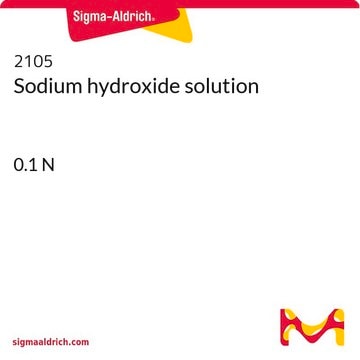1.09141
Sodium hydroxide solution
c(NaOH) = 0.1 mol/l (0.1 N), reag. Ph. Eur., reag. USP, ready-to-use volumetric solution for titration, Titriplex®
About This Item
Polecane produkty
product name
Sodium hydroxide solution, c(NaOH) = 0.1 mol/l (0.1 N), Titripur®, reag. Ph. Eur., reag. USP
agency
reag. Ph. Eur.
reag. USP
Poziom jakości
ciśnienie pary
3 mmHg ( 37 °C)
linia produktu
Titripur®
Postać
liquid
jakość
Analyzed in our ISO 17025 accredited QC lab
przydatność reakcji
reaction type: Acid-base reactions
opakowanie
Titripac® of
stężenie
0.1 M
metody
titration: suitable
pH
12.7 (20 °C in H2O)
gęstość
1.00 g/cm3 at 20 °C
temp. przechowywania
15-25°C
ciąg SMILES
[OH-].[Na+]
InChI
1S/Na.H2O/h;1H2/q+1;/p-1
Klucz InChI
HEMHJVSKTPXQMS-UHFFFAOYSA-M
Szukasz podobnych produktów? Odwiedź Przewodnik dotyczący porównywania produktów
Powiązane kategorie
Zastosowanie
- Adsorption Studies: Sodium hydroxide solution is used in treating polymer adsorbents to enhance their adsorption properties. A recent study investigated the effect of treating a PVC/Aliquat-336 polymer adsorbent with sodium hydroxide on chromium (VI) adsorption. The treatment improved the adsorption capacity of the polymer, making it more effective in removing heavy metals from aqueous solutions (Ouazine et al., International Journal of Environmental Analytical Chemistry, 2022).
- Synthesis of Sodium Ethoxide: Sodium hydroxide solution is employed in the synthesis of sodium ethoxide, an important reagent in organic synthesis. Research has demonstrated that sodium ethoxide can be synthesized efficiently at ambient temperature using sodium hydroxide and ethanol-90. This method offers a straightforward and cost-effective approach for preparing this key chemical intermediate (Randriana et al., World Journal of Applied Chemistry, 2021).
- Corrosion Inhibition: Sodium hydroxide solution is used in corrosion inhibition studies. Research has shown that an aqueous extract of Thespesia populnea plant leaves can effectively inhibit the corrosion of aluminum steel in sodium hydroxide solution. The study utilized electrochemical techniques to demonstrate the formation of a protective film on the steel surface, highlighting the potential of natural inhibitors in industrial applications (Brindha and Venkatraman, Research Journal of Chemistry and Environment, 2023).
Cechy i korzyści
This volumetric solution is analyzed by our calibration laboratory D-K-15185-01-00 which is accredited according to DIN EN ISO/IEC 17025 for analysis of amount-of-substance concentrations in volumetric solutions by DAkkS (Deutsche Akkreditierungsstelle - German National Accreditation Body). The accreditation certificate can be found at www.sigmaaldrich.com/ISO17025.
Opakowanie
Titripac® packaging - all SKU-pack size numbers ending "4000, 4003, 9010, 9013" - more information on www.sigmaaldrich.com/Titripac
Komentarz do analizy
Amount-of-substance concentration 0.0995 - 0.1005 mol/L
Measurement uncertainty ± 0.0003 mol/L
Traceability NIST SRM
The concentration is determined by volumetric titration and refers to 20°C.
The amount-of-substance concentration of this volumetric solution is traceable to a primary standard reference material (SRM) from the National Institute of Standards and Technology, Gaithersburg, USA (NIST SRM 84 potassium hydrogen phthalate) by means of volumetric standard potassium hydrogen phthalate (article number 1.02400), certified reference material according to ISO 17034, analyzed by our accredited calibration laboratory of Merck KGaA, Darmstadt, Germany according to DIN EN ISO/IEC 17025. The uncertainty is expressed as expanded measurement uncertainty with a coverage factor k=2 covering a confidence level of 95%.
Note: The titer is a correction factor to correct for variations of the volumetric solution, the titration equipment, the temperature and other laboratory conditions. For correct titration results it is recommended to determine a titer with the laboratory specific equipment and under laboratory specific conditions directly after opening a new bottle and at regular time intervals.
Informacje prawne
produkt powiązany
Hasło ostrzegawcze
Warning
Zwroty wskazujące rodzaj zagrożenia
Zwroty wskazujące środki ostrożności
Klasyfikacja zagrożeń
Met. Corr. 1
Kod klasy składowania
8B - Non-combustible corrosive hazardous materials
Klasa zagrożenia wodnego (WGK)
WGK 2
Temperatura zapłonu (°F)
Not applicable
Temperatura zapłonu (°C)
Not applicable
Certyfikaty analizy (CoA)
Poszukaj Certyfikaty analizy (CoA), wpisując numer partii/serii produktów. Numery serii i partii można znaleźć na etykiecie produktu po słowach „seria” lub „partia”.
Masz już ten produkt?
Dokumenty związane z niedawno zakupionymi produktami zostały zamieszczone w Bibliotece dokumentów.
Klienci oglądali również te produkty
Produkty
Application Note details preparation of peracetic acid standard solution for analytical quality assurance (AQA) in testing laboratories.
Powiązane treści
Miareczkowanie Karla Fischera określa zawartość wody w surowcach i produktach, co jest szeroko stosowaną metodą analityczną.
Karl Fischer titration determines water content in raw materials and products, a widely used analytical method.
FAS, or 'forever chemicals,' persist in the environment and pose risks to human health. Discover our environmental monitoring tools for PFAS quantification, aiding researchers, regulators, and labs in testing for PFAS.
PFAS, czyli "wieczne chemikalia", utrzymują się w środowisku i stanowią zagrożenie dla zdrowia ludzkiego. Odkryj nasze narzędzia do monitorowania środowiska w celu kwantyfikacji PFAS, pomagające badaczom, organom regulacyjnym i laboratoriom w testowaniu PFAS.
Nasz zespół naukowców ma doświadczenie we wszystkich obszarach badań, w tym w naukach przyrodniczych, materiałoznawstwie, syntezie chemicznej, chromatografii, analityce i wielu innych dziedzinach.
Skontaktuj się z zespołem ds. pomocy technicznej




